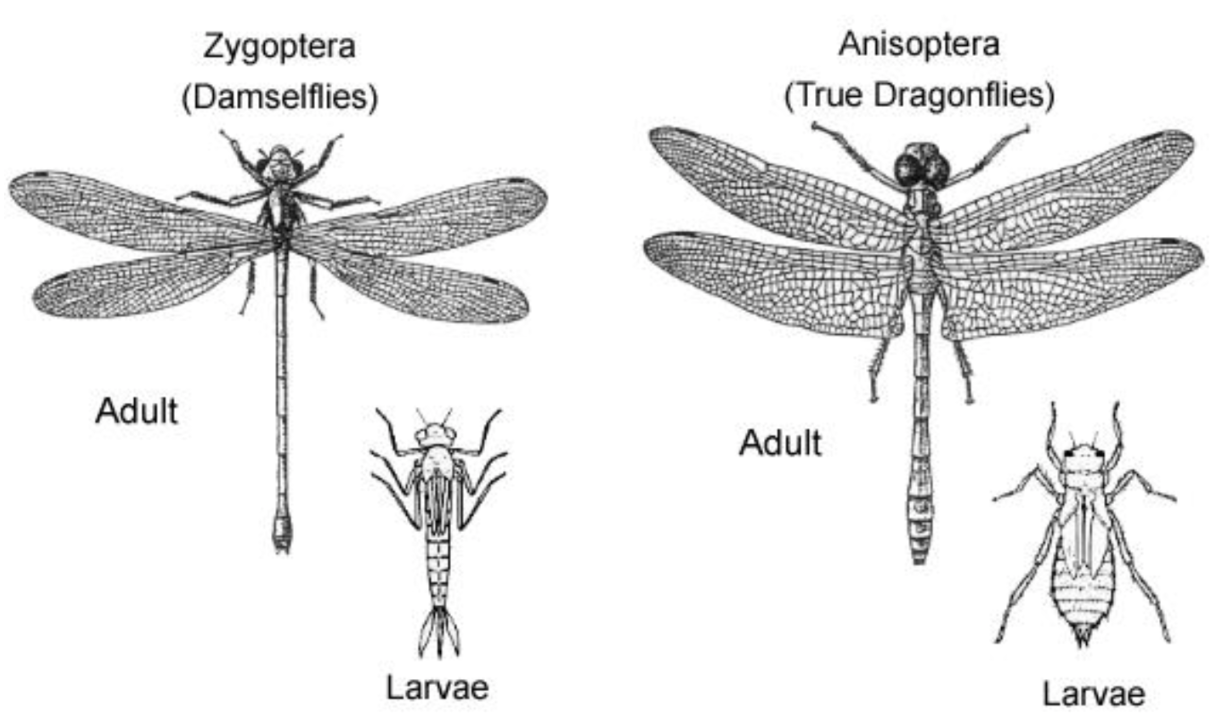2.1: Week 2- Reading
- Page ID
- 25929
Paleoptera & the Primitive Insects
There are two main groups of insect orders: the Paleoptera and the Neoptera. Just as it sounds, the Paleoptera are the more ancient of the insect orders, and only two remain extant: the Ephemeroptera and the Odonata. Members of these orders are hemimetabolous, meaning that they develop in stages with no pupal stage, and that the life stages are divided by habitat: the larvae develop in aquatic habitats while the adults are terrestrial. The Ephememeroptera (Mayflies) and Odonata (Damsel and Dragonflies) both have chewing mouthparts and two pairs of wings that cannot be folded over the insect’s back (no flexion), but beyond that there are few similarities (figure 2-1).

The Ephemeroptera are relatively small, delicate insects with 2-3 long terminal cerci. The majority of their life is spent developing and feeding as nymphs in aquatic habitat, and they represent a significant contribution to the food web and in nutrient cycling services. Once the nymphs are mature, they crawl from the water, shed their juvenile exoskeleton and enter the “dun” life stage – they are the ONLY insect order to have a winged stage that is not fully mature, requiring another life stage to reach full maturity. All other insects have completed development once the wings are fully formed. The dun life stage is usually drab in color and does not last long before the mayfly molts into the mature adult, or “spinner”. This life stage will reproduce, mate, and females will lay eggs in the water. Many species will not feed as adults, having atrophied mouthparts or guts. Few species have been identified as at least partially parthenogenic. In one peculiar case,the species Eurylophella oviruptis, about 60% of the population emerges and follows the typically understood life cycle, mating and lating eggs, but the other 40% of the population are markedly different. This remaining group will reach a mature nymph stage, but instead of emerging the nymphs float to the surface of the water and rupture their abdominal wall, spreading viable eggs across the water.
In application, the Ephemeroptera can be used as Bio-indicators in aquatic habitats, as we examined with the Plecoptera in the first lab. The known tolerances to a range of environmental factors in aquatic systems are well known and can be used to identify potential sites of disturbance, as well as monitor the efficacy of ecological restoration.
Odonata represents two sub-Orders of insects, the Anisoptera (the dragonflies) and the Zygoptera (the damselflies). These two orders are represented by relatively large insects with elongate wings. They are aerial predators, and thus have evolved excellent visual perception with large compound eyes with smaller, simple ocelli – used for discerning light and dark to orient in flight. The antennae are reduced to short, bristle like protrusions that do not interfere with aerodynamics. Adult damselflies are somewhat smaller and more delicate that dragonflies, especially in the Willamette Valley.
Juveniles for both Odonate orders are aquatic, and predatory in this stage as well. They are large bodied nymphs with large, hinged mouthparts used for ambush predation. Zygoptera nymphs are easily distinguished by the long, fealther-like gills at the terminal end of the insect, while Anisoptera juveniles absorb oxygen from the water using gills held internally in the rectal chambers, pumping their abdomen to increase flow over the structures (figure 2-2).

Of the Neoptera, one of the most primitive orders is the Blattodea (cockroaches and termites). Termites may seem very different from cockroaches outwardly, but genetic evidence has revealed how closely related these insects are, even sharing some similar behaviors.
The cockroaches are very simple insects, most well-known for the species that will densely aggregate in urban settings. Adults are alive for the development of their offspring, and familial colonies can become quite large rapidly. Because of the varied food resources exploited by cockroaches, they are reliant on symbiotic gut microbes for digestion. They are not born with the gut microbes required, they must be supplied by the adults in the colony. The cockroaches will engage in trophallixis,vomiting into the mouths of the other individuals in the colony to spread the gut microbes. Additionally, the young will eat feces and engage in anal trophallaxis to gain microbe cultures. This behavior is also seen in the termites, which require gut microbes to digest tough woody fibers.
The termites, but comparison, exhibit complex social structure which may have evolved from the close familial colonies in the cockroaches. Termites are primarily underground or in well-sheltered substrate, and are wingless and soft-bodied (unsclerotized) until the time comes for the colony to reproduce. The reproductive “king” and “queen” in the colony will then allow new reproductive to develop, maturing to relative large, sclerotized, winged adults that will leave the colony and disperse to new areas (usually annually in temperate climes). The two pairs of wings, when present, are long and attached to the thorax with flexible bases, making it easy for them to break off once the flighted termites have found a new habitat.
The social structure is known as a “caste system”. Each individual termite develops as a pseudergate, or a non-differentiated termite caste, helping with nest work throughout the juvenile stages. The termite will either remain a worker, become a soldier, or even develop into a reproductive. The castes are determined by the presence of oppressive pheromones secreted by the others in each caste. As the older insects die, the relative amounts of their pheromone decreases, allowing more pseudergates to develop into the caste. For example, if the queen dies she can no longer emit Queen Pheromone, which suppresses the sexual development of all other females. The pheromone’s level in the colony drops, and female pseudergates begin to sexually mature until a reproductive replacement is in place.


